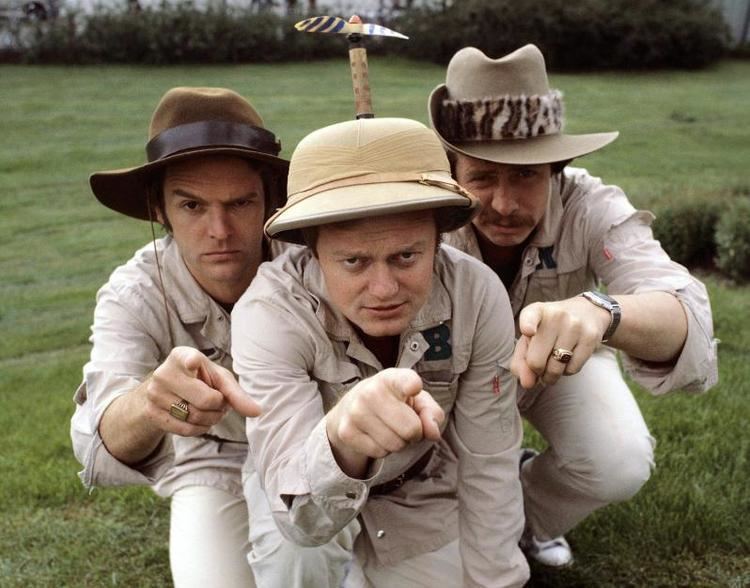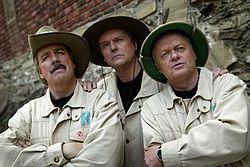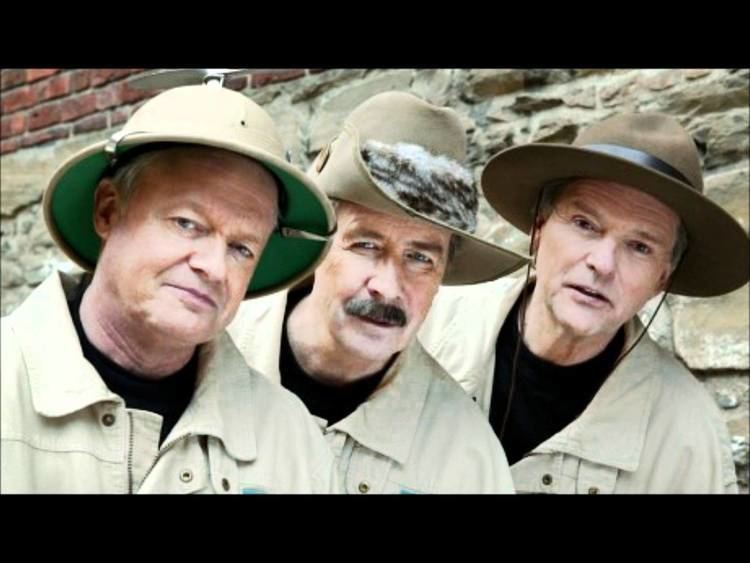Country of origin Norway No. of episodes 48 + 1 movie Final episode date 16 March 2005 Language Norwegian | No. of seasons 4 First episode date 27 January 1979 Number of seasons 4 | |
 | ||
Created by Lars MjøenKnut LystadTrond KirkvaagEivind AaengKalle Fürst Starring Lars MjøenKnut LystadTrond KirkvaagandTom Mathisen Running time 15-25 minutes(1979-1994)30 minutes2005 Cast Similar Brødrene Dal og Legende, MK‑X, Krem Nasjonal, Rodde & Kikkan, AF1 | ||
Brødrene Dal ('The Brothers Dal') is a Norwegian television series by Norwegian comedy trio KLM (Kirkvaag, Lystad, Mjøen), that originally aired as four series in 1979, 1982, 1994 and 2005. A fifth adventure, originally performed on stage in 1997, was edited and released as a movie in 2010.
Contents
- Main Characters
- Secondary Characters
- Prof Drvels Secret Professor Drvels Hemmelighet
- The Spectral Stones Spektralsteinene
- The Legend of Atlant Ice Legenden om Atlant Is
- The Mystery of Charles XIIs spats Mysteriet om Karl XIIs gamasjer
- Planned fifth series
- The Curse of the Viking Sword Vikingssverdets forbannelse
- Home media
- References

The series bears many similarities to Monty Python's Flying Circus, as the three actors play nearly all the different roles in the series, often multiple roles in each episode. Usually, the series would have a main plot keeping the story and episodes together, but most of the content being semi-related or unrelated sketches. This is especially true for the first series Professor Drøvels Hemmelighet (1979), where the story frequently diverges from the main plot for entire episodes, only to jump back to the plot in the last minute. In the other series, the story is more centered on the actual plot.

Main Characters

Secondary Characters

Prof. Drøvel's Secret (Professor Drøvels Hemmelighet)

Originally aired in 1979 with 13 episodes (15 minutes each, except the first and last episode, 25 minutes) The main plot of this adventure takes place on the fictional unexplored river Overfloden, where the brothers are searching for the long-lost professor Drøvel, who mysteriously disappeared while exploring the river 25 years earlier. However, the episodes frequently diverge from the main plot into unrelated sketches.
The Spectral Stones (Spektralsteinene)

Originally aired in 1982 with 13 episodes (15 minutes each, except the first and last episode, which are 25 minutes long). In this adventure, the brothers (with the help of a blueprint delivered by an alien spaceship) build a machine that travels through time and space, powered by the mysterious spectral stones, the source of incredible power. At each destination (which includes the Viking Age, the Old West, ancient Egypt, 18th century France, and a desert island) the brothers must find a new spectral stone in order to eventually get back to their own time.
The Legend of Atlant-Ice (Legenden om Atlant-Is)
Originally aired in 1994, with 12 episodes (20 minutes each). this adventure focus on the brothers' search for the lost sacred Saami city of Atlant-Is (Atlant-Ice), whilst investigating strange activities nearby. This was the first series to feature main characters other than the three brothers and narrator, and was originally planned to be the final series about the brothers.
The Mystery of Charles XII's spats (Mysteriet om Karl XIIs gamasjer)
Originally aired in 2005 with ten 30 minute episodes. With the 100th anniversary of the union dissolution approaching, the brothers must travel back in time to find King Charles XII's long-lost spats that disappeared some 300 years ago. If they do not recover the spats before the anniversary, Norway will be forced to re-enter a union with Sweden. This is the last series about the brothers, following Kirkvaag's death in 2007.
Planned fifth series
Following the success of the latest series, production was commissioned in 2006 for a fifth series, but Kirkvaag's illness delayed the project, ultimately bringing it to a halt as he began treatment. When it became clear that he was in no condition to film a full, new series, the project was scrapped in favor of a re-editing of their 1997 stage performance (See below).
The Curse of the Viking Sword (Vikingssverdets forbannelse)
Originally performed on stage in 1997, this adventure was edited and released as a feature film in 2010. Gaus and Roms are accidentally sent back in time to the Viking Age, while Brumund is left behind in the present, and must help his brothers get back to their own time via video link. After the failure to produce a fifth series, the two remaining members of the trio began working on the project in 2007, and it was released in theaters on 10 September 2010. Trond Kirkvaag's parts were recorded separately before his death from colorectal cancer, whilst the rest of the movie was edited from the 1997 recordings. Editing was completed in 2009, and it was released in 2010.
Home media
In addition to several reruns since first being aired, the first two series were released on VHS in 1988. The third series were released on VHS in 1995, before all three series were re-released on DVD in 2000, albeit in non-restored forms, using the VHS masters. In 2010, all four series of the show were released on remastered DVDs both individually and as a box set.
No plans have been announced regarding a Blu-ray release. The first two series were shot on 35 mm film, whilst the third and fourth were shot digitally.
